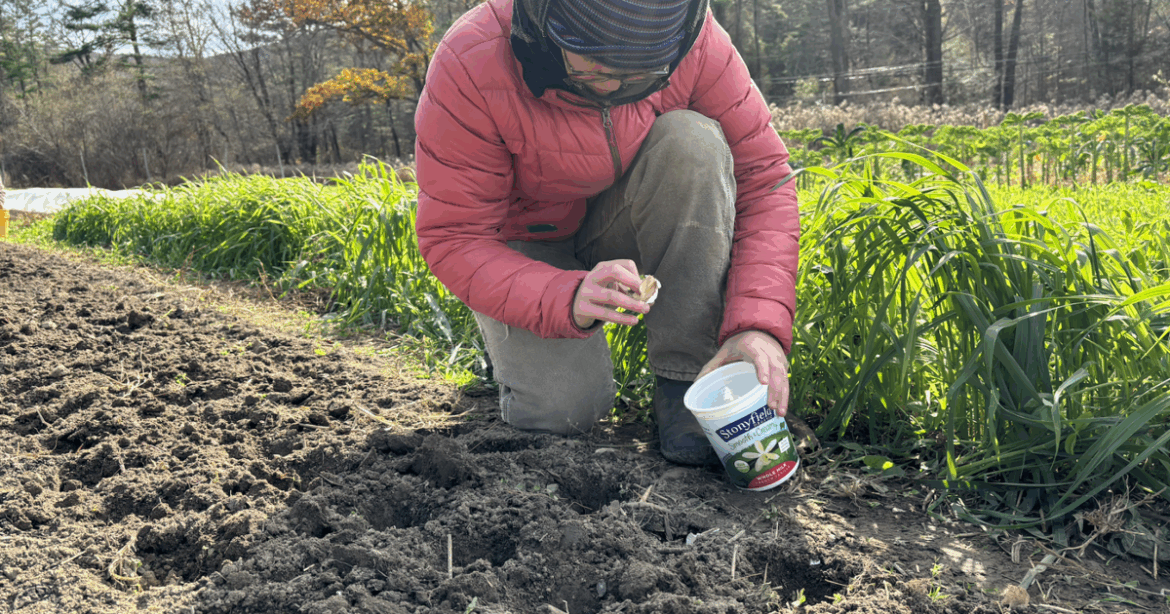Chodesh Tov, and welcome to the month of Cheshvan!
Also called Mar-Cheshvan, or “bitter Cheshvan,” this new moon arrives in the wake of so many gatherings and festivals that it can feel a bit empty. As we integrate all the holiness received in Tishrei, we are gifted with extra time this month.
Carly Sugar planting garlic.
For gardeners, it’s a welcome pause — a chance to preserve the harvest, prepare for the first frost and dream about next year. Cheshvan is also the month for one of my favorite garden activities: planting garlic. Garlic is the backbone of my kitchen, a gift that keeps giving in the garden, and it holds deep significance for the Jewish people.
Early Romans dubbed Jews “garlic eaters.” Today, modern garlic eaters like me reclaim the term with pride. Growing up, my dad affectionately called me “Garlic Breath,” a play on my first and middle names, Carly Beth. And it’s true — I love the flavor. Garlic grown in the garden is remarkable: some varieties are mild, sweet and earthy, while others are sharp and hot, with nutty or fruity notes. Hardneck varieties, best suited for our colder climate, offer an extra bonus: garlic scapes, the long, curling stems of the garlic flower. Harvesting scapes brings garlic flavor into the kitchen early and ensures larger heads later in the summer. Many gardeners will sort the harvested heads, saving the largest as seed garlic for next year and hanging the rest to dry.
You can even decorate your kitchen corners with clusters of braided garlic. Use as many as you like, if you don’t mind the aroma. That strong, earthy scent is more than flavor; it connects us to our ancestors and their enduring traditions.
Across the diaspora, Jewish folklore highlights garlic’s protective powers and its ability to ward off the ayin hara, or evil eye. In Ladino, the phrase “Al ajo ke se la vaiga / Let it go to the garlic,” was said to deflect envy after a compliment. In some Sephardic traditions, a clove is placed under a mother’s pillow during delivery or under a sleeping newborn. Among Ashkenazi Jews, garlic was hung near doors and windows, worn around the neck or carried in pockets while traveling, believed to guard against sickness and misfortune. These cloves were protective talismans but also seeds. I like to imagine my ancestors carrying garlic for protection as they journeyed to safer lands, then planting it upon arrival — a hopeful blessing that would multiply tenfold, offering abundance and protection in the years to come.
Garlic requires a few cold, dormant months before emerging in spring. Here in Zone 6b, we plant it in mid-to-late November, under a thick layer of straw mulch.
It doesn’t take up much space: Cloves can be planted 6 inches apart, with the skin intact to protect against mold and bacteria. Planted pointy end up, each clove will yield a full head the following summer. You can save the largest heads as seed garlic for next year, watching garlic’s gifts multiplying again and again.
If you haven’t grown it yet, I encourage you to find local seed garlic at farmers’ markets or garden suppliers and give it a try. Planting garlic brings a sense of hope, of connection to our ancestors and excitement for the future.
May we carry these seeds of sweetness in our pockets through any bitter times ahead.
Chodesh tov, fellow garlic eaters.
A Year in Jewish Gardening is a column exploring rhythms of the Hebrew calendar and our region’s agricultural season. Each month, around the new moon, Carly Sugar of Chamomile Gardens shares reflections from forest and field, insights from Jewish tradition, and practical vegetable gardening tips — helping you cultivate a deeper connection to the land and bring the farm-to-table movement to your own backyard.




Comments are closed.